Coronavirus (COVID-19): public attitudes and behaviours - April update
Findings from polling work, conducted between September 2021 and January 2022, on public attitudes and behaviours around the coronavirus pandemic in Scotland.
This document is part of a collection
8. Vaccines
The vaccination programme was in full swing throughout September to January, with the focus moving to booster jabs. By 1 September 2021, 83.5% of Scottish adults had received two doses of the vaccine.[20] However, with the effectiveness of vaccines waning over time, third/booster vaccines were recommended.[21] Boosters started to be administered to care home residents from 20 September, with other priority groups to follow. With the arrival of the Omicron variant and rapid infections, there was greater urgency to deliver the booster rollout. By December, boosters were being offered to all adults across Scotland.
This section covers:
- how many respondents have received a vaccine and how many doses
- respondents' likeliness to get a vaccine if they haven't yet received/aren't fully vaccinated
- reasoning behind why some are unlikely to get a vaccine/booster
- attitudes towards the vaccine certification scheme
Vaccines received
Figure 49 visualises booster uptake, shown in orange, amongst respondents over autumn/winter. As we would expect to see, as time progressed, more respondents received a booster vaccine as it was made available to them. By the beginning of October, respondents had started to receive their booster vaccines (4%). This increased steadily throughout this time period, and at 18-19 January, 79% of respondents had received their booster vaccine in addition to their first and second vaccines.
The percentage of respondents who had not received any COVID-19 vaccine was highest at 7% at 7-8 September. The proportion of respondents who had not received a vaccine from mid-September to January hovers around 5% (4%-6%). In other words, 1 in 20 respondents had not received any COVID-19 vaccine. And a further 2% to 4% preferred not to answer.
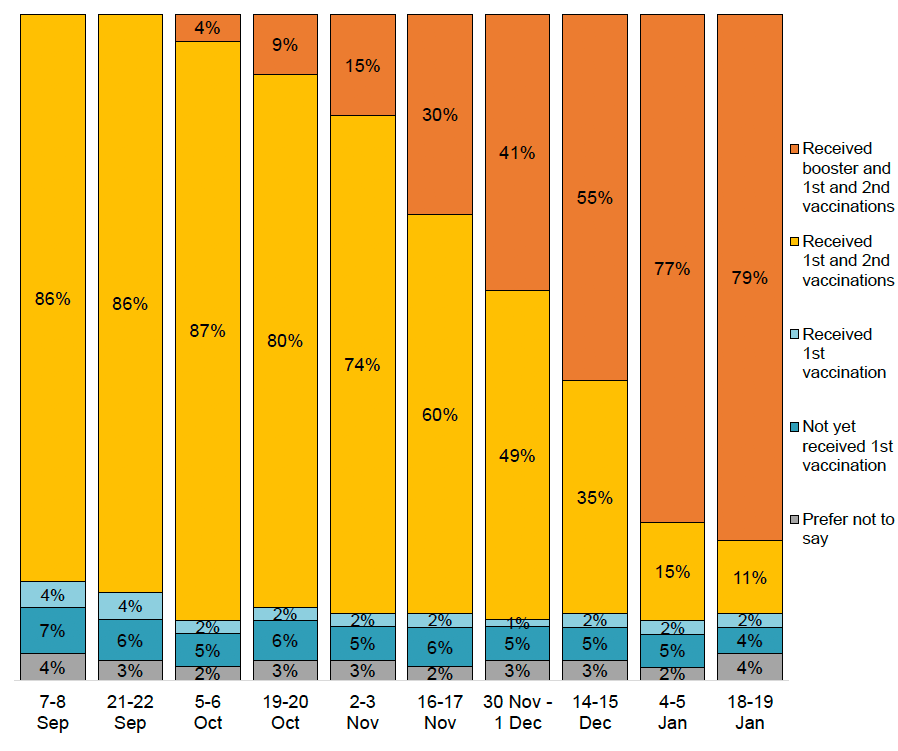
Source: YouGov Scotland Survey. Base: Adults (1001-1044)
Respondents who were still awaiting any vaccine were then asked how likely or unlikely they were to be vaccinated for Coronavirus when a/their next vaccine became available to them (Figure 50). This was asked on a scale of 0-10, with 0 being 'extremely unlikely' and 10 being 'extremely likely'. If respondents had already received a first vaccination, they were asked how likely or unlikely they were to have their second. And if they had already received their second vaccination, they were asked how likely or unlikely they were to have a Coronavirus booster vaccine when it was offered to them.
From October to January, the number of respondents who had not yet received their 1st or 2nd vaccine was increasingly fewer. This goes hand-in-hand with the large proportion of these respondents who had said they were 'extremely likely' (scoring 8-10) to get a vaccine or booster dose once available to them. As we would expect to see, more respondents took up the vaccine as they became available to them over time. As time goes on, the sample of respondents who had not yet received a 1st or 2nd vaccine gets smaller (n=982 at 5-6 October, n=159 at 18-19 January), while the proportion among those who are undecided gets bigger: from around 1 in 10 respondents to 3 in 10 (10%-32%). However, in actual numbers (not proportions/percentages), only a small number of respondents are undecided due to the decreasing sample of unvaccinated respondents.
The trend in the proportion of respondents who are 'extremely unlikely' to get vaccinated is similar to the 'undecided'. As the number of respondents who haven't yet received a 1st or 2nd vaccine decreases, the proportion among them who scored 0-2 (total unlikely) gets bigger: from 7% in October to 33% in January.
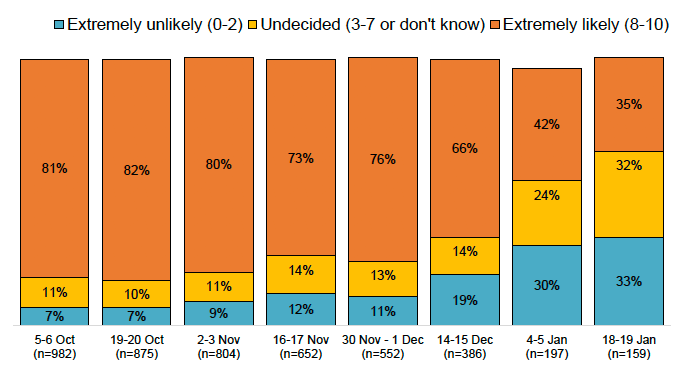
Source: YouGov Scotland Survey. Base: Adults who are still to have any vaccination (n=159-982)
Reasons why respondents were less likely to get a vaccine/booster
Respondents who had scored 0-7 (from the scale where 0 is 'extremely unlikely' and 10 is 'extremely likely') on likelihood to get any vaccine (1st, 2nd or booster) were asked to select all/any reasons that apply for why not (Figure 51). Separately, at 21-22 September, respondents were asked specifically about their likelihood to get a booster once it became available to them and for their reasons why not (Figure 52).
Note that people may have different views towards receiving different doses of the vaccine. For example, 42% of respondents said they'd be less likely to get a booster vaccine at 21-22 September because they deem two doses to be sufficient (see Figure 52).
The main reasons respondents gave for why they would be less likely to take any vaccine/booster at 16-17 November and 18-19 January were to do with personal safety concerns, or lack of concern. The top reasons included:
- any mention of vaccine safety concerns (42% in November to 46% in January)
- any mention of a having a reaction to the vaccine (36% to 35%)
- any mention of the virus being low risk/not serious (24% to 37%)
- any mention of other people/countries needing vaccines more (26% to 23%)
- any general vaccine barrier (20% to 15%)
Meanwhile, the top reasons around the unlikelihood of getting a booster, specifically, asked at 21-22 September, were to do with other people/countries needing vaccines more (42%), as well as the belief that the two doses they had received so far were enough (also 42%).[22]
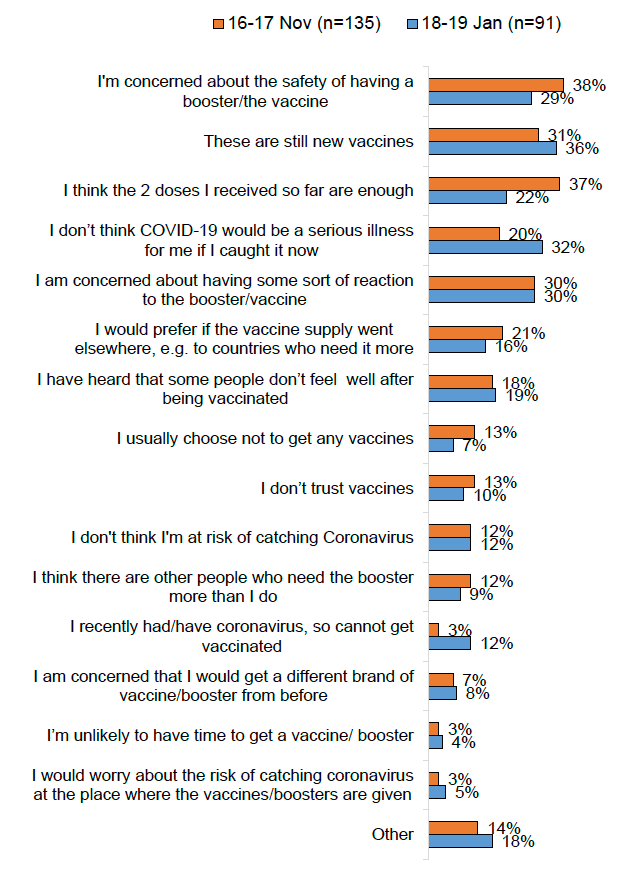
Source: YouGov Scotland Survey. Base: All adults who ranked 0-7 on likelihood to get a COVID-19 booster or have first or second vaccine (n=91-135)
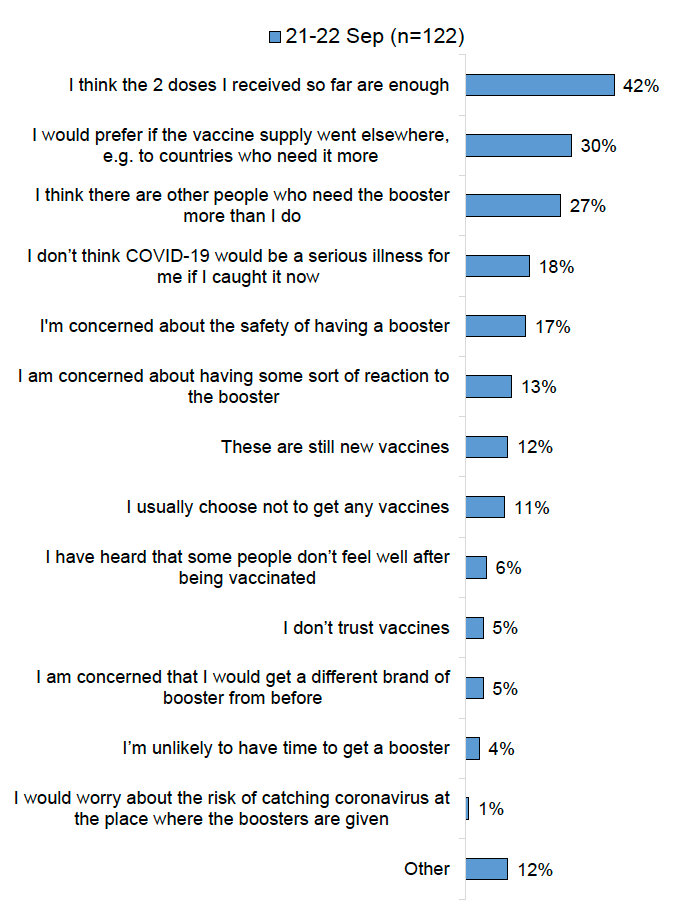
Source: YouGov Scotland Survey. Base: Adults who ranked 0-7 on likelihood to get COVID-19 booster (n=122)
Certification
The Scottish Government launched a COVID-19 certification scheme (also known as a "Covid passport" scheme), enforced from 18 October, for entry to venues such as nightclubs and for large events.[23]
Support for the COVID-19 certification scheme remains fairly stable, with over half of respondents (54% to 60%) supporting it from before its launch in September and after it was implemented and enforced from October through to December (Figure 53). Meanwhile around 1 in 5 respondents opposed the scheme (20% to 27%). All respondents were asked this question. However, only a small proportion each time had attended venues where they would need to show COVID-19 certification.
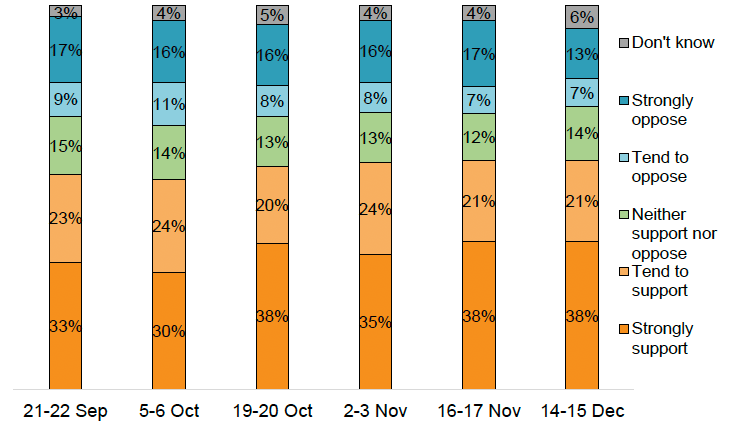
Source: YouGov Scotland Survey. Base: Adults (1002-1044)
Contact
Email: covid-19.behaviours@gov.scot
There is a problem
Thanks for your feedback